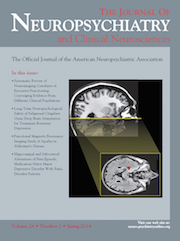To the Editor: ECT is an effective, safe, and tolerable treatment for psychiatric disorders, including depression, schizophrenia, and bipolar disorders. It is also applied to medication-resistant psychiatric disorders. However, somatic and cognitive side effects such as headache, nausea, memory disturbances, and delirium are commonly reported after ECT.
1,2 The most worrisome cognitive side effect is potentially life-threatening delirium, which may become the limitation of ECT. Postictal delirium usually resolves rapidly, but prolonged delirium sometimes occurs and may last from hours to several days.
3 Structural, metabolic, endocrine disturbances, and medications may cause prolonged delirium.
3 Hyperammonemia, which causes an acute onset of impaired consciousness, lethargy, and focal neurological signs or symptoms, is also one important condition to be monitored.
3–5 Hyperammonemia is reported from patients who have suffered from seizure attacks, especially the generalized tonic-clonic type, without abnormal liver function and valproic acid use.
6–8 In addition, ECT is one kind of generalized tonic-clonic seizure. We report on a patient with treatment-resistant bipolar I disorder, manic episode who received ECT and then developed hyperammonemia and prolonged delirium.
Case Report
A 53-year-old man who has a 14-year history of bipolar I disorder, with several depressed and manic episodes, was admitted to our acute ward due to current irritability, pressure of speech, decreased need of sleep, quarrels, and violent behaviors. His original medication was quetiapine 200 mg/day, and we increased it to 900 mg/day in the first week. Then we added lithium 900 mg/day due to persistent irritability and violent behaviors. Because of the poor response to the prescribed medication, ECT was started after the patient was admitted for 2 weeks. ECT was performed three times a week with bilaterally placed electrodes administering 25 J. After six rounds of ECT, his irritability lessened, but fluctuating conscious disturbance and disorientation to time and place occurred, even on days without ECT. Delirium became even worse after the ninth ECT. We discontinued lithium and decreased quetiapine to 400 mg/day, but the delirium persisted. The laboratory data of a complete blood count, liver function, renal function, and electrolytes were all within normal range. A brain CT showed senile brain atrophy without recent infarct or intracranial hemorrhage. There were no neurological or infectious signs either. Then we checked the ammonia level after the 10th ECT and it was 80 μg/dL. The normal ranges for ammonia levels are 12–66 μg/dL. The ammonia level for this patient increased to 92 μg/dL after the 11th ECT. Lactulose 40 mL/day was then prescribed for suspected hyperammonemia-induced delirium. The ammonia level after the final (12th) ECT decreased to 52 μg/dL. Delirium improved a little and lactulose was discontinued. However, delirium persisted and the ammonia level measured 2 days later was 81 μg/dL. We did not add lactulose again. Delirium improved gradually and he was oriented 3 days after the last ECT. The ammonia level the next day and 2 weeks later was 63 and 35 μg/dL, respectively. The patient was discharged under stable mood conditions and fair consciousness.
Discussion
ECT or seizure itself does cause postictal delirium, but other conditions must be screened, especially in prolonged delirium.
3 The mechanism of ECT-induced delirium is not very clear. Patients with repetitive seizures often have prolonged delirium.
3 In this case, we did not use valproic acid. Physical, laboratory, and brain image examinations showed normal findings, except for the ammonia level after ECT. Delirium became worse after a series of ECT but improved gradually after ECT was discontinued. The ammonia levels were high after two ECT treatments, but returned within normal range on the fourth day after the last ECT. Thus, ECT-induced hyperammonemia and delirium was highly suspected.
Hyperammonemia occurs in many conditions.
9 Extreme muscle contractions during seizure induce ammonia production by deaminating adenosine monophosphate in the purine nucleotide cycle. Although there are several studies of generalized tonic-clonic seizure-induced hyperammonemia,
6–8 no ECT-induced hyperammonemia and associated prolonged delirium were reported. Postictal hyperammonemia is reported to last for only several hours, but it is found after only one seizure attack.
7 In our case, the numbers of consecutive ECT and hyperammonemia correlate with the severity of delirium. Thus, it is possible that hyperammonemia is one of the mechanisms of ECT-induced prolonged delirium.
Treatment of secondary hyperammonemia includes removal of causing agents and the addition of L-carnitine, lactulose, or neomycin as adjunctive therapy.
9,10 Lactulose is a nonabsorbable disaccharide. It not only has laxative effects, but also reduces colonic pH and interferes with mucosal uptake of glutamine. Therefore, the synthesis and absorption of ammonia are reduced by lactulose.
10 Some studies of postictal hyperammonemia suggest no ammonia-lowering agents due to the self-limited nature.
7 In our case, the severity of delirium and hyperammonemia continued to worsen during the last three treatments of ECT; therefore, lactulose was added for 3 days. Lactulose did work to lower the ammonia level and severity of delirium, and was discontinued after the last ECT. However, mild delirium persisted, and hyperammonemia was found again. Due to the speculation on ECT-induced hyperammonemia and delirium, lactulose was not prescribed. The patient recovered from the delirium spontaneously. It shows that the hyperammonemia is self-limited after ECT is discontinued. The treatment effect of lactulose to improve hyperammonemia and delirium induced by ECT is also clearly observed.
To the best of our knowledge, this is the first report showing the relationship between the repetitive ECT-induced hyperammonemia and prolonged delirium. This case suggests that hyperammonemia must be monitored in ECT-induced delirium and lactulose has a role in treatment.

